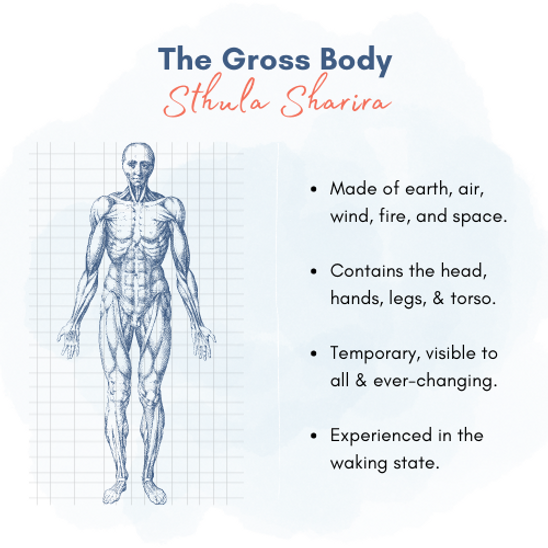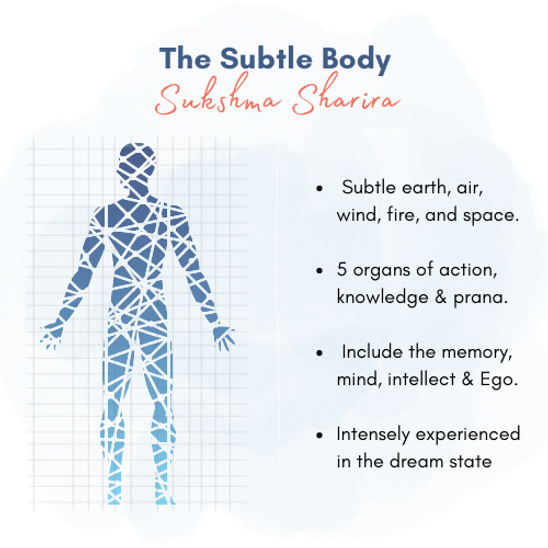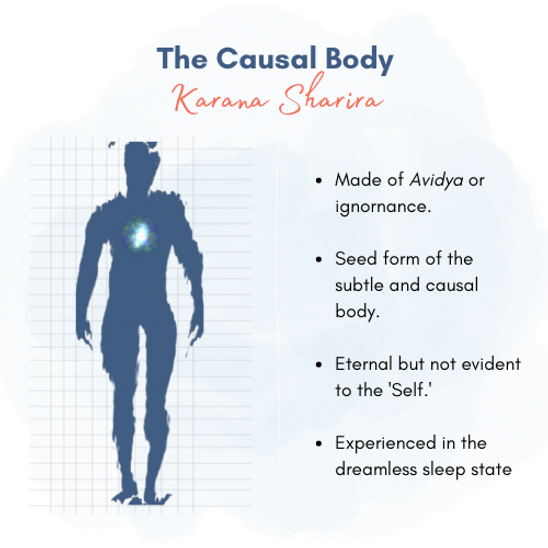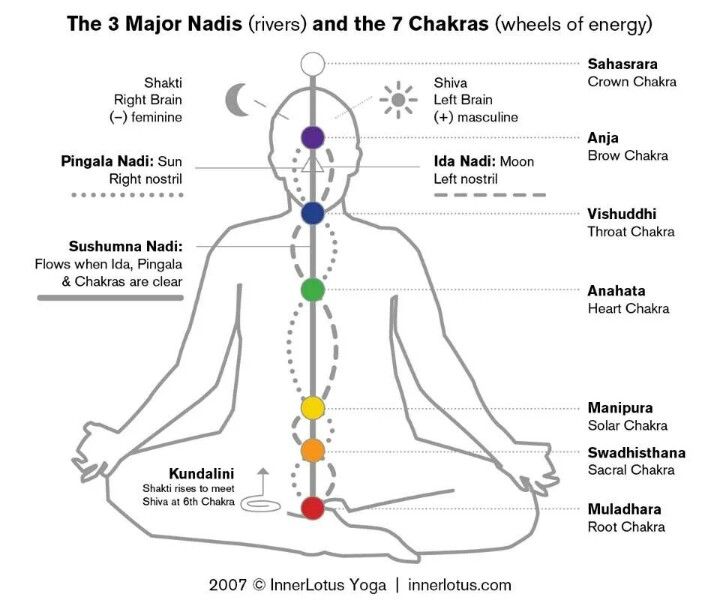To allow us to gain a better understanding of a chakra based yoga class, it’s important that we have a basic grasp of some key yogic concepts. There are entire volumes of text explaining all of the following concepts in very great detail, should you wish to explore further.
Presented here is a (relatively!) brief introduction to provide a working knowledge.
I have 3 bodies?
In yoga philosophy, the human being is understood to be composed of three bodies (Shariras), each with its own characteristics and functions. These are the Gross Body (Sthula Sharira), the Subtle Body (Sukshma Sharira), and the Causal Body (Karana Sharira).

The Gross Body is the physical body that we can see, touch, and perceive through our five senses. It is made up of the physical elements (earth, water, fire, air, and ether) and is the vehicle for our experiences in the material world.
It is the instrument for action, movement, and interaction with the external environment and is also the container for the other two bodies.
The Gross Body is mortal and subject to decay and death and is left behind at the end of each life.

The Subtle Body is an energetic and mental body that exists beyond the physical body and is the bridge between the Gross and Causal Bodies.
It is composed of the mind, intellect, ego, consciousness, and the vital life force energy (Prana) that flows through a network of energy channels (Nadis) and centers (Chakras).
It is the carrier of our thoughts, emotions, memories, and karmic imprints. It is the vehicle for our experiences in the dream state and during the transition after death.
The subtle body is more enduring than the gross body and transmigrates with the soul (Jiva) to a new Gross Body at the time of reincarnation. It dissolves only upon liberation (Moksha).

The Causal Body is the subtlest of the three bodies and is considered the seed or cause of the Subtle and Gross bodies. It is the repository of our deepest unconscious tendencies, karmas (actions), and Samskaras (mental impressions) accumulated over lifetimes.
It is the blueprint for our future experiences and the link to the cycle of birth and death. It is experienced as a state of deep sleep or undifferentiated consciousness.
The Causal Body is the longest-lasting and dissolves only when all karmas are resolved and liberation is attained.
In essence, the Gross Body is the physical shell, the Subtle Body is the energetic and mental framework that animates it and carries our experiences, and the Causal Body is the underlying karmic blueprint that determines the nature of our experiences and future lives.
The goal of yoga is often described as understanding and transcending these three bodies to realize the true Self (Atman), which is beyond these layers.
I thought yoga was just bending and stretching?
It’s easy to understand that a physical yoga class can affect the Gross Body, by stretching muscles and improving flexibilty, mobility and posture and even reducing heart rate and improving digestion. With a little knowledge and some imagination we can also affect our Subtle Body as well.
In yoga, Nadis (“rivers”) refer to a network of Subtle Energy Channels through which Prana, or life force energy, flows. Nadis are not physical nerves or blood vessels, but rather energetic pathways in the Subtle Body and are the channels that carry Prana throughout the body.
A healthy flow of Prana is essential for physical, mental, and spiritual well-being and blockages or imbalances in the Nadis can lead to various health problems.
The three main nadis are Ida, Pingala and Sushumna.
Ida Nadi represents the lunar, feminine, and cooling energy and is associated with the left nostril and the right hemisphere of the brain. It relates to mental and emotional processes.
Ida helps regulate the parasympathetic nervous system, promoting relaxation and introspection.
Pingala Nadi represents the solar, masculine, and heating energy and is associated with the right nostril and the left hemisphere of the brain. It relates to physical energy and activity.
Pingala is associated with the sympathetic nervous system and energizes us for action and engagement with the external world.
Sushumna Nadi is the central channel that runs along the spine and is considered the most important nadi.
It runs along the spine from the base (Muladhara chakra) to the crown (Sahasrara chakra) and it represents balance between feminine and masculine energies.
It is only activated when both Ida and Pingala are harmonized. Sushumna is vital for spiritual awakening and is directly connected to the chakras
These three major nadis originate at the base of the spine and travel upward. The Sushumna Nadi is centrally located and travels along the spinal canal.
The Ida and Pingala Nadis also travel upward along the spinal column, but they crisscross each other and the Sushumna before terminating in the left and right nostrils, respectively.
Techniques like Nadi Shodhana (alternate nostril breathing) help balance Ida and Pingala while clearing Sushumna.
The junctions where the Ida, Pingala, and Sushumna Nadis meet along the spinal column are called Chakras.
Just as the spokes of a wheel radiate outward from a central hub, so do the other nadis radiate outward from the Chakras to other parts of the body.

Shakras or Chakras
Pronounced with a hard ch as in church, Chakras (literally “wheels”) are energy centres within the Subtle Body.
There are seven main Chakras and they act as focal points where Prana accumulates before being distributed through various Nadis. Each chakra draws energy from its corresponding Nadi, Ida or Pingala, and redistributes it throughout our body via Sushumna.
Chakras influence our physical, emotional, and spiritual well-being. When they are balanced, energy flows freely, promoting health and harmony.
When they are blocked or out of balance, it can lead to various issues and can disrupt energy flow throughout other regions.
The Root Chakra (Muladhara) is located at the base of the spine and is Red. It represents grounding, security and survival and is associated with our connection to the earth and physical body.
The Sacral Chakra (Svadhisthana) is located at the lower abdomen, just below the navel and is orange. It represents creativity, sexuality, emotions and pleasure and is associated with our ability to experience and express emotions.
The Solar Plexus Chakra (Manipura) is located in the upper abdomen, in the stomach area and is yellow. It represents our power, confidence and willpower and is associated with our sense of personal power and self-esteem.
The Heart Chakra (Anahata) is located Center of the chest and is Green. It represents love, compassion and empathy and is associated with our ability to give and receive love.
The Throat Chakra (Vishuddha) is located in the throat and is blue. It represents communication, self-expression and truth and is associated with our ability to communicate effectively.
The Third Eye Chakra (Ajna) is located between the eyebrows and is indigo. It represents intuition, wisdom and insight and is associated with our ability to perceive beyond the physical world.
The Crown Chakra (Sahasrara) is located at the top of the head and violet or white. It represents spiritual connection, enlightenment and consciousness and is associated with our connection to the divine and universal consciousness.
Why visualise Chakras during yoga?
During Specific Asanas (poses or postures) as we hold the pose, we can bring our awareness to the Chakra that is stimulated or balanced by that pose, and by focusing on each Chakra individually and visualising its colour, location, and associated qualities we can balance and unblock them.
The aim is to clear any blockages in the Chakras and promote a smoother flow of Prana (life force energy) throughout the body.
Bringing our attention to the Chakra locations can enhance our internal awareness and connection to our physical and energetic body. We can also benefit from increased focus, as visualisation provides a focal point during the poses, helping to keep the mind present and engaged.
As each chakra is associated with specific emotions, qualities, and aspects of our being, visualisation can help to bring awareness to and balance these aspects. For example, visualising the heart chakra as green and radiant might cultivate feelings of love and compassion.
For some of us, Chakra work is a way to deepen our spiritual practice and connect with a more subtle level of existence.
Om shanti,
Jim 🙏😊

